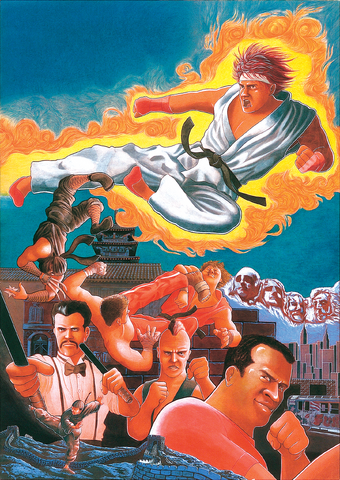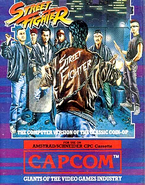Street Fighter (ストリートファイター, Sutorîto Faitâ) is a 1987 arcade game developed by Capcom. It is the first competitive fighting game produced by the company and the inaugural game in the Street Fighter series. While it did not achieve the same popularity as its sequels (particularly Street Fighter II) when it was first released, the original Street Fighter introduced some of the conventions made standard in later fighting games, such as six attack buttons (only found on some versions of the game) and special command based techniques. Character art was drawn by Bengus.
Characters
| Playable Characters |
|---|
| Ryu |
| Ken Masters |
| Non-playable Characters |
|---|
| Gen |
| Birdie |
| Eagle |
| Adon |
| Sagat (Final boss) |
| Geki |
| Joe |
| Lee |
| Mike |
| Retsu |
Gameplay
The original Street Fighter features a cast of twelve fighters: two playable characters and ten CPU-controlled opponents.
The player takes control of a Japanese martial artist named Ryu, who competes in an international martial arts tournament to prove his strength. The second player takes control of Ryu's former training partner and rival Ken Masters, who challenges Ryu in the game's 2-player matches. Normally the player takes control of Ryu in the single-player mode, however if the player controlling Ken defeats Ryu in a 2-player match, then the winning player will play the remainder of the game as Ken. The differences between the characters are mainly aesthetic, as both of them have the same moves and techniques.
Unlike subsequent Street Fighter games, the player cannot choose his or her own character. Instead, the first player is assigned to play as Ryu, while a second player can join in and play as Ken in competitive matches. The player can perform all three of Ryu and Ken's signature special moves, but the timing is very difficult. Also unlike later games, doing 1 or 3 of these moves could easily defeat an opponent in a matter of seconds.
The single-player mode consists of a series of battles against ten opponents from five different nations. At the beginning of the game, the player can choose the country where their first match will take place, with available choices of Japan or the United States, as well as China or England, depending on the DIP switch setting. The player will then proceed to fight against the nation's two representing opponents before proceeding to the next country. In addition to the regular battles, there also two types of bonus games which player can compete for additional points, including a table breaking and brick breaking bonus games. After defeating the initial eight, the player will travel to Thailand to fight against the final two opponents.
Each match is a series rounds in which the player must defeat their opponent in less than 30 seconds. If a match ends before a fighter is knocked out, then the fighter with the greater amount of hit points left will be declared the round's winner. The player must win two rounds in order to defeat their opponent and proceed to the next battle. If the third round ends in a tie, then the computer-controlled opponent will win by default or both players will lose. During the single-player mode, the player can continue after losing and fight against the opponent they lost the match with. Likewise, a second player can interrupt a single-player match and challenge the other player to a match.
The game controls consists of an eight-directional joystick and depending on the cabinet: six attack buttons, three punch buttons and three kick buttons of differing speed and strength; or two mechatronic pads for punches and kicks that determined the strength level of the player's attacks. The player uses the joystick to move towards or away from an opponent, as well to jump, crouch and defend against an opponent's attacks. By using the attack buttons/pads in combination with the joystick, the player can perform a variety of attacks from a standing, jumping or crouching positions. There were also three special techniques, performed by inputting a specific directional-based command and button combination. These techniques were the Hadoken, the Shoryuken and the Tatsumaki Senpukyaku. Unlike the subsequent Street Fighter sequels and other later fighting games, the specific commands for these special moves were not given in the arcade game's instruction card, which instead encouraged the player to discover these techniques on their own.
Development
Street Fighter was directed by Takashi Nishiyama and planned by Hiroshi Matsumoto, who both previously worked on the overhead beat 'em up Avengers. The two men would leave Capcom after the production of the game and were employed by SNK (now known as SNK Playmore), developing most of their fighting games.
Trivia
- Of all the characters in the game, only Ryu, Ken and Sagat returned in the game's immediate (and more famous) sequel Street Fighter II. Birdie, Adon and Gen would later resurface in the Street Fighter Alpha games. Eagle resurfaced in the crossover game Capcom vs. SNK 2 after a fourteen year absence and later appeared in the handheld versions of Street Fighter Alpha 3.
- While Joe, Mike, Lee, Geki and Retsu are the only characters who never returned or appeared playable in later Street Fighter games, they have appeared in other Street Fighter-related media.
- Joe and Mike were given updated designs in the Street Fighter V website.
- Lee appeared in the Street Fighter manga Sakura Ganbaru!, in the second comic of Udon's comic book miniseries Street Fighter Legends and as a card in SNK vs. Capcom: Card Fighters Clash.
- Geki appeared in the third comic of Udon's Street Fighter Legends series (where in UDON's Street Fighter continuity, Geki is not an individual, but an entire clan of ninjas known as the Geki Clan). In Street Fighter X Tekken, Geki's costume appears as a alternate costume (refered in-game as "Swap Costume") for Tekken character Lars Alexandersson.
- Retsu appeared in Udon's Street Fighter comics as well as in their Street Fighter Origins: Akuma comic. Retsu also plays a role in a pair of Japan-exclusive Street Fighter II Drama CDs. He also appeared as a card in SNK vs. Capcom: Card Fighters Clash.
- It should be noted that Mike and Joe look-alikes were seen in the Street Fighter II arcade intro, but were never playable or seen in-game. According to the Street Fighter V website, the Mike and Joe look-alike characters are different persons named Max and Scott respectively.[1][2]
- The game was included on volume 2 of Capcom Classics Collection for the PlayStation 2 and Xbox.
Credits
Arcade Version [Staff]
Direction: Piston Takash
Planning: Finish Hiroshi
Programming: FZ 2151
Character Design: Crusher Ichi, Dabada Atsushi, Bonsoir Yuko, Ocan Miyuki, Bravo Oyu, Innocent Saicho
Sound and Music: Yuukichyans Papa
Hard Planning: Punch Kubozo
Mechatronics: Strong Take, Radish Kamin
Special Thanks: Short Arm Seigo, Melanin Kazu, Puttun Midori, James Nyama, Seinto Sinn
Additionally, Street Fighter, like many other games during this era of gaming, credited its staff in its default Score Ranking Table, which is as follows:
- 1st 101800 HRO
- 2nd 95400 RYO
- 3rd 90000 NAT
- 4th 86000 MIM
- 5th 83200 TAR
- 6th 78000 WAK
- 7th 63100 KTU
- 8th 60400 TOR
- 9th 59800 BAB
- 10th 50000 KEI
TurboGrafx-CD Version [Fighting Street]
- Original Game Staff
Direction: Piston Takashi
Planning: Finish Hiroshi
Programming: FZ 2151
Character Design: Crusher Ichi, Dabada Atsushi, Bonsoir Yuko, Ocan Miyuki, Bravo Oyu, Innocent Saicho
Sound & Music: Yuukichyans Papa
Hard Planning: Punch Kubozo
Mechatronics: Strong Take, Radish Kamin
Special Thanks: Short Arm Seigo, Melanin Kazu, Puttun Midori, James Nyama, Seinto Sinn
- PC-Engine CD-ROM Staff
Programmers: 68K‑62Conv. Hahi, Kouji Yamamoto, Hiroto Sasaki, Takeshi Takamine, Tetsuya Sasaki, Yav, Yoshinozui
Designers: Lovely Okada, Cutie Itoh, Honey Kakutani, Fancy Motoko
Sound Director: Toshi Sasagawa
Music Producer: N.Nakagami
Arranged by: Shofuku
Sound Effect: AX‑1 Iwabuchi, Lu.Takahashi
Technical Adviser: Takaki Kobayashi, Yoshio Motosako, Sexy Nonchan
Special Thanks: Hiromasa Iwasaki, Capcom, Musical Plan Ltd
Produce: Alfa System
Schedule Manager: Katsuhiro Nozawa
Superviser: Shin Nakamoto
Executive Producer: Yukio Ohsato
©1988 Hudson Soft
©1987 Capcom



